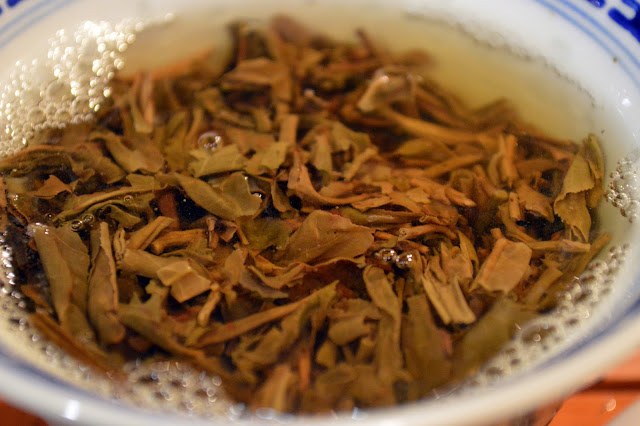Wild Jungle Sheng Maocha
A little while ago I acquired a couple pounds of a "wild jungle sheng mao cha" dating back to the year 2000. Although technically not a pu'er as this tea comes from Laos, it is a pu'er and has been exceptionally aged. Picked and processed by the Dai people just across the border from Yunnan, the wild tea plants and associated leaves are delicious and exhibit many of the characteristics that I love about this style of pu'er. The leaves are very large and thick, coming from the summer harvest. They were minimally processed, being sun-dried before being piled and aged. Opening up the bag, the classic "funk" of a good pu'er wafted out and overwhelmed my senses. The tea brewed up to a smooth, slightly sweet brew with a slight viscosity that coated the tongue before slowly revealing the subtle flavors.
Sharing the tea with friends, all seem to really enjoy it and it has been selling really well, even to a few green tea fans who enjoy it's ability to not turn astringent on longer steeps. People really overlook aged maocha in my mind, thinking that cakes are where it is at when it comes to pu'er, but to my mind a good aged maocha can be exceptional, and often just as good as an aged cake pu'er but for less money. Something like this one will never be found on the market again, and so I will be holding on to as much of it as possible to slowly put out over the next couple years. If you happen to come into the cafe and see a "wild green sheng" available, I strongly suggest you give it a try.
The readings I got on this were:
Water
TDS - 87ppm
PH - 7.56
Tea
TDS - 484ppm
PH - 5.95
Difference
TDS - 397ppm
PH - 1.61
This was a really good extraction, as I usually only get that much TDS change in black teas. The PH change is a bit above the normal pu'er, but not a total outlier.
2005 Liming Spring High Mountain Sheng
I got one cake of this 2005 gushu to try before buying the entire tong. A couple people have put forth a negative impression of the factory, which is located in the Menghai area and is one of the oldest pu'er factories, having been established in 1964, but from what I can tell they have done so to simply push their own pu'er and agenda. Others have noted how Liming, which also produces under the name Ba Jiao Ting (which is the label of their higher quality products), has been noted for its consistency, quality, and push towards organic tea. The online world is full of players pushing their own agenda - I try and ignore that and let the tea speak for itself. So I ordered a cake, as the price was favorable and I wanted to try the tea.
I enjoyed it - my notes include "nice, alert, hay and honey, lingering through the nose, good digestion, a touch dry in aging." It did not have the viscosity or slowly rising chi of the Wild Jungle Sheng above, but I was able to pull a 5 hour standing counter shift with no breaks right after enjoying this tea and felt great the whole time, so that should speak to something. I will order a tong and see what the customers say, but think it will go over well.
 |
| This photo shows the difference in leaf size between the spring Liming cake and the summer Wild Jungle maocha. Quite the difference! |
Here are the numbers I got:
Water
TDS - 53ppm
PH - 6.95
Tea
TDS - 388ppm
PH - 6.07
Difference
TDS - 335ppm
PH - .88
Another good extraction, although not as high as the Wild Jungle Sheng above. The PH change was also much less, indicating that the leaves released less carbon into the water, most likely because they are 5 years younger.










Excellent article, fantastic observations and very interesting to see you use TDS and PH testing ��
ReplyDelete